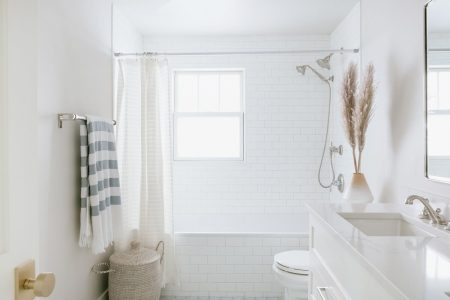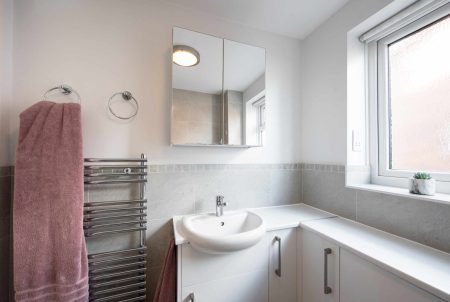Bathroom exhaust fans are required by the NEC (National Electrical Code) and local building codes for any bathroom that doesn’t have a window that can be opened to provide ventilation. In some jurisdictions, they are required even if windows are present. Bathroom exhaust fans must be vented to the outside through ductwork or sidewalls.
Installing a bathroom exhaust fan is worth the time and effort because it removes hot, moist air and odors. Moist air leads to mold growth and odors lead to general unpleasantness.
But installing a weak, undersized exhaust fan is almost not worth the effort, even if the fan meets the minimum requirements. It’s important to understand how vent fans are sized and how to choose one with the proper capacity for your space.
Watch Now: How to Choose and Install a Bathroom Exhaust Fan
Types of Bathroom Exhaust Fans
There’s a difference between an exhaust fan and ventilation fan; an exhaust fan draws air out and a ventilation fan brings fresh air in. If you have to replace a bathroom exhaust fan, your best bet is to go with the type that’s already in place. Four types of bathroom exhaust fans include:
- Ceiling mount: A ceiling-mounted bathroom exhaust fan is the most popular type of bathroom exhaust fan. It works by connecting to an exhaust duct above the bathroom.
- Wall mount: A wall-mounted fan is used when a ceiling mount is not practical. The wall mount fan vents directly outdoors without the need for exhaust ductwork.
- Inline: An inline exhaust fan is installed in a remote location and taps into the ductwork in the attic. There’s a grill installed in the bathroom ceiling connecting the system.
- Window mount: Though not as popular as other types, a window-mounted bathroom fan can be inserted just like a window-mounted air conditioner.
Standard Fan Sizing
Bathroom vent fans are rated for the amount of air they can move, measured in cubic feet per minute, or CFM. Standard fan sizing applies to bathrooms that are 100 square feet or less. The rule of thumb is that you need at least 1 CFM per square foot of room area.
To determine the square footage of your bathroom, multiply the length times the width. For example, if your bathroom is six feet wide and nine feet long, its square footage is 54. Therefore, it should have a fan rated for at least 54 CFM. But before you start shopping, there are a few things to consider.
- First, it’s a good idea to oversize the fan slightly. In our sample 54-square-foot, for example, it’s a good idea to install a 60 CFM fan for good measure.
- Second, if your bathroom has a jetted tub or separate rooms or alcoves, you might want more than one fan.
- The minimum allowed fan size is 50 CFM, so if your bathroom is, for example, only 42 square feet, you still need a 50 CFM fan.
When sizing a vent fan, a factor to consider is duct size and length. Most 50 CFM fans will run well with a 4-inch round duct. But as you get up into the higher CFM fans, duct size will have to be increased to a 5- or 6-inch round duct. The length of the run, as well as the number of fittings and elbows will also affect the amount of air your duct can effectively carry.
There are somewhat complicated formulas for calculating proper duct size for different length runs and configurations, but the instructions that come with the fan will outline the requirements. Just make sure there is sufficient space for the ductwork in the area where you’re installing the fan. Trying to force too much air through an undersized duct will make the fan work too hard and will provide insufficient venting.
Need more help? Talk to a bathroom fan expert
Our partners can help you compare quotes from top-rated professionals near you.
Get a Quote
Sizing for Large Bathrooms
For bathrooms over 100 square feet, exhaust fans can be sized according to the number of fixtures in the room. To calculate using this formula, add up the required CFM ratings for all of the fixtures:
- Bathtub: 50 CFM
- Jetted tub: 100 CFM
- Shower: 50 CFM
- Toilet: 50 CFM
For example, if your bathroom includes just a shower and a toilet, it needs a 100 CFM fan, while a bathroom with a jetted tub, toilet, and shower needs a 200 CFM fan.
Another calculation method with three steps is useful for large rooms with high ceilings (well over 8 feet). In this method, multiply the square footage by the ceiling height, divide by 60 (minutes in one hour), then multiply by eight (recommended number of air exchanges per hour). For example, for a room that’s 120 square feet and has a 10-foot ceiling:
- 120 x 10 = 1,200
- 1,200 divided by 60 = 20
- 20 x 8 = 160 CFM
Fan Noise Ratings
Once you’ve chosen the right fan size for your bathroom, consider the sound rating, as demonstrated by the sone rating of each fan. (Sone rating is a measure of loudness.) A quiet fan might be a worthy investment, particularly in a bathroom you’d like to make peaceful and relaxing. The lower the sone number, the quieter the fan will sound when running. A sone rating of “1” is the quietest fan you can buy. Here are other sone ratings compared to other sounds:
- 1-sone rating equals a refrigerator’s hum or whisper (about 28 decibels)
- 2-sone rating equals ambient sounds in a library (about 38 decibels)
- 3-sone rating equals a low conversation (almost 44 decibels)
- 4-sone rating equals the sound of a television (almost 48 decibels)
- 5-sone rating equals sounds of moderate rainfall (about 51 decibels)
A Second Fan May Be Needed
If your bathroom has a toilet or shower area enclosed by a door, it’s a good idea to install a separate exhaust fan for that area. If the enclosed space is small, a 50 CFM fan should suffice. Otherwise, use the appropriate calculation based on the room size. Just remember that the fan needs airflow to do its job.
If the door to the enclosure is closed and there’s no gap at the bottom of the door, the fan will be starved of “makeup” air and will perform poorly. If the gap under the door in an enclosure is less than 5/8 inch, you should leave the door slightly ajar when using the toilet or shower when the enclosure’s vent fan is running. Another solution is to install a louvered door that allows airflow.
Read the full article here














